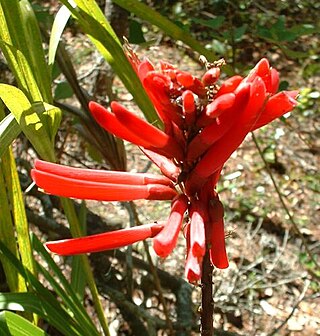
Erythrina herbacea, commonly known as the coral bean, Cherokee bean, Mamou plant in South Louisiana, red cardinal or cardinal spear, is a flowering shrub or small tree found throughout the southeastern United States and northeastern Mexico; it has also been reported from parts of Central America and, as an introduced species, from Pakistan. Various other systematic names have been used for this plant in the past, including Erythrina arborea, Erythrina hederifolia, Erythrina humilis, Erythrina rubicunda, Corallodendron herbaceum and Xyphanthus hederifolius.

Strychnos nux-vomica, the strychnine tree, also known as nux vomica, poison fruit, semen strychnos, and quaker buttons, is a deciduous tree native to India and to southeast Asia. It is a medium-sized tree in the family Loganiaceae that grows in open habitats. Its leaves are ovate and 5–9 centimetres (2–3.5 in) in size. It is known for being the natural source of the extremely poisonous compound strychnine.
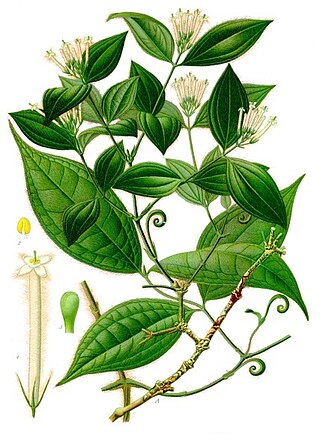
Strychnos is a genus of flowering plants, belonging to the family Loganiaceae. The genus includes about 100 accepted species of trees and lianas, and more than 200 that are as yet unresolved. The genus is widely distributed around the world's tropics and is noted for the presence of poisonous indole alkaloids in the roots, stems and leaves of various species. Among these alkaloids are the well-known and virulent poisons strychnine and curare.

Myrica is a genus of about 35–50 species of small trees and shrubs in the family Myricaceae, order Fagales. The genus has a wide distribution, including Africa, Asia, Europe, North America and South America, and missing only from Australia. Some botanists split the genus into two genera on the basis of the catkin and fruit structure, restricting Myrica to a few species, and treating the others in Morella.

Curare is a common name for various alkaloid arrow poisons originating from plant extracts. Used as a paralyzing agent by indigenous peoples in Central and South America for hunting and for therapeutic purposes, curare only becomes active when it contaminates a wound. These poisons cause weakness of the skeletal muscles and, when administered in a sufficient dose, eventual death by asphyxiation due to paralysis of the diaphragm. Curare is prepared by boiling the bark of one of the dozens of plant sources, leaving a dark, heavy paste that can be applied to arrow or dart heads. In medicine, curare has been used as a treatment for tetanus and strychnine poisoning and as a paralyzing agent for surgical procedures.
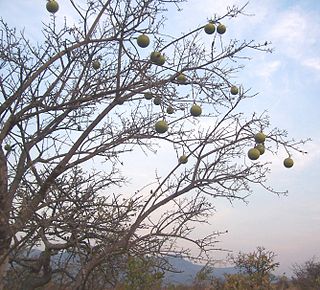
Strychnos spinosa, the Natal orange, is a tree indigenous to tropical and subtropical Africa. It produces sweet-sour, yellow fruits, containing numerous hard brown seeds. Greenish-white flowers grow in dense heads at the ends of branches. The fruits tend to appear only after good rains. It is related to the deadly Strychnos nux-vomica, which contains strychnine. The smooth, hard fruit are large and green, ripen to yellow colour. Inside the fruit are tightly packed seeds, which may be toxic, surrounded by a fleshy, brown, edible covering. Animals such as baboon, monkeys, bushpig, nyala and eland eat the fruit. The leaves are a popular food source for browsers such as duiker, kudu, impala, steenbok, nyala and elephant.

Memecylon is a plant group in Melastomataceae. It consists of 350-400 species of small to medium-sized trees and shrubs occurring in the Old World tropics. Memecylon is a monophyletic group basal to the Melastomataceae clade. Memecylon taxa have more than 600 published basionyms. Diversity of this group is concentrated in tropical Africa, Madagascar, Sri Lanka, India and Malaysia.

Antiaris toxicaria is a tree in the mulberry and fig family, Moraceae. It is the only species currently recognized in the genus Antiaris. The genus Antiaris was at one time considered to consist of several species, but is now regarded as just one variable species which can be further divided into five subspecies. One significant difference within the species is that the size of the fruit decreases as one travels from Africa to Polynesia. Antiaris has a remarkably wide distribution in tropical regions, occurring in Australia, tropical Asia, tropical Africa, Indonesia, the Philippines, Tonga, and various other tropical islands. Its seeds are spread by various birds and bats, and it is not clear how many of the populations are essentially invasive. The species is of interest as a source of wood, bark cloth, and pharmacological or toxic substances.

Alchornea cordifolia is a shrub or small tree distributed throughout tropical Africa, it can grow up to 8 metres tall. The plant is used in traditional African medicine. Common name is the Christmas bush.

Berberis aristata, also known as Indian barberry, Mara manjal (மரமஞ்சள்),"chutro" or "sumbal" ortree turmeric, is a shrub belonging to the family Berberidaceae and the genus Berberis. The genus comprises approximately 450-500 species of deciduous evergreen shrubs and is found in the temperate and sub-tropical regions of Asia, Europe, and America. B. aristata is native to the Himalayas in India and in Nepal. It is also naturally found in the Nilgiri Mountains of southern India and in Sri Lanka.

Strychnos madagascariensis, the black monkey orange, is an African tropical and sub-tropical tree belonging to the Loganiaceae family. It is a tree with characteristically large fruit but can confused with some other species of the genus.

Maerua angolensis is a 10m tall, occasionally deciduous tree of the Capparaceae or caper family, often growing on termitaria and in thickets fringing seasonal watercourses, up to 1800m. Though never common, it is widespread in tropical Africa and arid regions, being absent from high-rainfall regions.
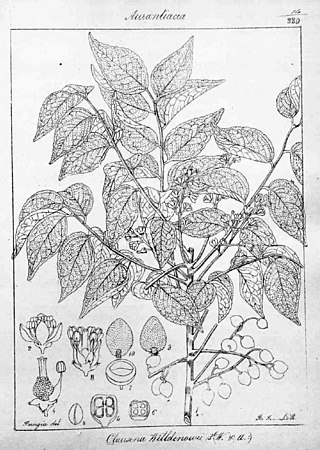
Clausena anisata (Willd.) Hook.f. ex Benth. is a deciduous shrub or small tree, belonging to the Rutaceae or Citrus family, and widespread in the Afrotropical realm or Sub-Saharan Africa, but absent from the drier regions. It is also found in tropical and South-East Asia, growing in India and Sri Lanka and extending as far as Queensland in north-eastern Australia and some Pacific islands. It is cultivated in Malaysia and Indonesia. As with other plants useful to mankind its large range of medicinal properties has led to a global distribution and its growth wherever the climate is suitable. It grows in higher-rainfall regions in savanna, thickets, riverine forest, disturbed areas and secondary forest, up to an altitude of 3000 m. The leaves, which are foetid when bruised, give rise to the common name 'Horsewood' or the more descriptive Afrikaans common name 'Perdepis', meaning 'horse urine'.

Klainedoxa gabonensis is a large tropical African tree of the family Irvingiaceae growing to 40m in height. Its straight trunk is buttressed and up to 25m long, while its spreading evergreen crown makes it one of the largest trees of the rainforest. It is found from Senegal to Sudan, Cameroons, Ivory Coast, Democratic Republic of the Congo, Uganda and Tanzania, growing as far south as Angola and Zambia.
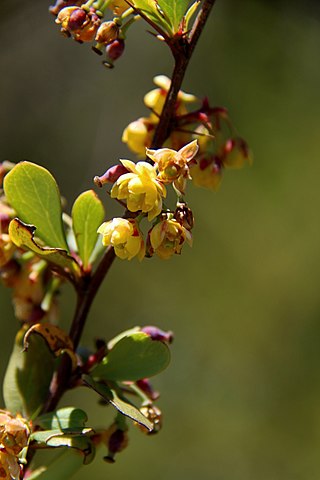
Berberis holstii is a spiny evergreen shrub assigned to the barberry family, with simple leaves, hanging panicles with a few yellow flowers and eventually blackish-blue berries. It is one out of only species of Berberis that grow in the wild in Africa, where it can be found at high altitudes in Tanzania, Uganda, Kenya, Ethiopia, Somalia, and Malawi. It is also reported from Yemen and Oman. In Malawi it is known as Kayunga, while in Ethiopia it is called Gewo, Yeset af in Amharic, as well as Zinkila, a name also used in the Afar language, and Godxantool in the Somali language.
Mostuea is one of only three genera of flowering plants belonging to the small family Gelsemiaceae. Mostuea and Gelsemium were formerly placed in the family Loganiaceae, while Pteleocarpa was placed variously in the families Icacinaceae, Cardiopteridaceae, Boraginaceae, and others, before the description of the Gelsemiaceae was altered formally to accommodate it in 2014. Mostuea is native to Africa and South America. Anecdotal evidence suggests that the roots of certain Mostuea species are used as ritual aphrodisiacs and entheogens in West Tropical Africa.
Strychnos icaja is a species belonging to the plant family Loganiaceae, native to West Tropical Africa. It is a very large, tropical rainforest liana which may attain a length of 100 m (330 ft).
Lannea schweinfurthii is a small to medium sized deciduous tree within the Anacardiaceae family. The tree is sometimes called 'bastard marula' or 'false marula' because when it is without flowers or fruits, it become quite similar to the marula tree and sometimes confused for the marula tree. Extracts of the species is used in traditional human and veterinary medical practices.
















